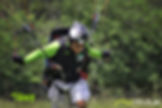



Courses
Paragliding is very accessible for people of all ages and fitness levels, most will successfully complete the course and enjoy the freedom of flying solo.
A paragliding proficiency rating is obtained by attending training through a qualified instructor. These courses can be completed in as little time as nine days. Once qualified, continued practice and learning helps progress the pilots’ skills and safety.
BEGINNER / class "A"
Paragliding courseThis paragliding course in conjunction
with the basic knowledge of the principals of aerodynamics and micrometeorology and combined with direct instruction from a qualified instructor will help you to develop the skills necessary to Master the art of paragliding .
During your first day you will meet your instructor who will show you and brief you on the training hill and what is expected from you .At that time the instructor will show you the different components of a paraglidier ,what the different components do and any other pertinent information related to the paragliding wing ,the harness, proper clothing to wear and foot ware will also be discussed .At that time your only task is to become familiar with the equipment and how to inflate the glider .
Day 2-
Five point safety check. Practice building a wall (inflating the Paraglider) and practice of bringing the wing up above your head checking for proper inflation ,"look at your wing "while demonstrating full control of the wing .This will be done repetitiously until the instructor is satisfied ,you are adept at performing this task before moving on to the next step . Inflating and proper launch posture .Landing and flarering (braking )
Day 3-
09.00-11.00 Theory discussion
Basic meteorology
Basic knowledge of aerodynamics
Basic technics on how to launch and piloting or active flying
Rules of flying in a site where other pilots are airborne (flying)
More discussions on the equipment you are using and different flying scenarios .
Five point safety check .Practice of launching and landing at the training hill the rest of the day.
Day 4-
09.00-11.00
Theory discussion
Five point safety check. Practice Reverse and forward launch technics,while demonstrating control and perfecting the launch technics.While under the supervision of your instructor. You will practice these technics repeatedly until you have shown you can inflate, launch and control the glider while on the training hill .
Day 5-
On this day basic theory will be discussed .Why we need to do a flight plan .The use of a radio.
Five point safety check .Practice launch technics on the training hill. The instructor will be watching to determine if you have progressed sufficiently for a launch from higher altitude . All of the criteria's discussed above have to be met and the instructor has to be convince that you can perform all of these tasks without any doubts .Having said that usually in the evening when the wind is calm and the thermal have subsided,your instructor may decide to guide you on your first high altitude flight ,with radio instructions.
At this time he will ask you to perform a series of turns ,surge control and basic" L " or "S" landing approach.
Your performance on this first flight will be discussed at the end of the flight and if possible another flight will be made.
Day 6-
More theory will be discussed. An evaluation of previous flight will prompt your instructor to focus on a particular area of your technic that may need improvement . You will continue to do (sled ) rides multiple launches ,while improving on the basics of flight ,paragliding input ,delaminating weather conditions at launch and at LZ landing approach and landing .
Day 7-
Theory discussion ,weather discussion ,basic cloud formations, preflight check
If so determined by your instructor you will launch and perform under radio instructions 8 turns or continuous S turns 360 turns and other descending technics such as asymmetrical or BIG EARS and engaging speed bar .During these excessive you will be required to control ,pitch , yaw and surge as the Paraglider is being given input it will require active flying on the part of the student .the student is expected to maintain a heading and controlled flight path after exiting each manuver .
Day 8-
Flight plan,Five point safety check Reverse Inflation .Emergency descending technics 8 s ,360 turns BIG EARS and engage speed bar .repetition may seem redundant but the students goal is to master the reactions and inputs needed to archive active flying .Choose landing field of your choice and plan for an emergency landing
Day 9-
Flight plan Discussion about thermals and Theory .
Student will demonstrate his or her ability to form good judgment about weather conditions and has to have met all the skill levels required by the instructor during flight.
While in radio contact and if conditions allow the instructor will guide the student into a thermal, student will demonstrate his or her ability to turn into the thermal and fly (ascend )
with other pilots following all the rules of basic flight ,safely . Weight shift,360 and the proper way to exit a thermal ,active flight is required
Day 10-
Theory test
A pre determined flight plan will be chosen by the instructor .The student must make his own determinations about the weather conditions and if possible will launch and follow the flight plan discussed at launch. This will end the course a class "A "certified pilot.
--We don’t just make pilots; we make lifelong friends
Antonio Rosario Aquino





